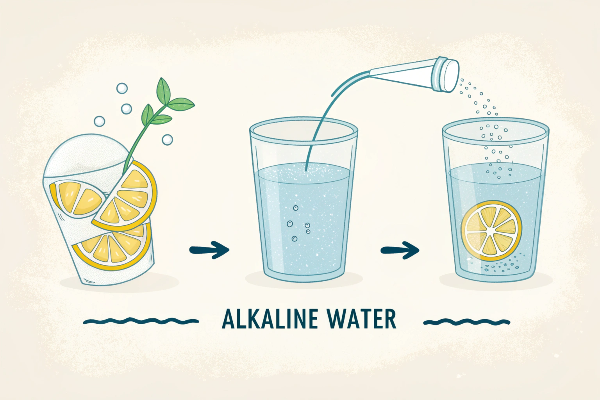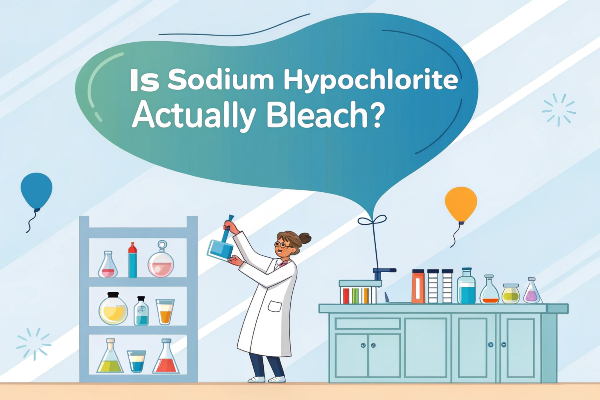Are you feeling the pressure to find sustainable energy solutions? The shift to green energy is critical, but scaling up hydrogen production is proving to be a real headache.
Titanium anodes are essential for large-scale hydrogen production via electrolysis because they offer superior corrosion resistance, durability, and efficiency compared to other materials, making them a key component in advancing electrolysis technology.
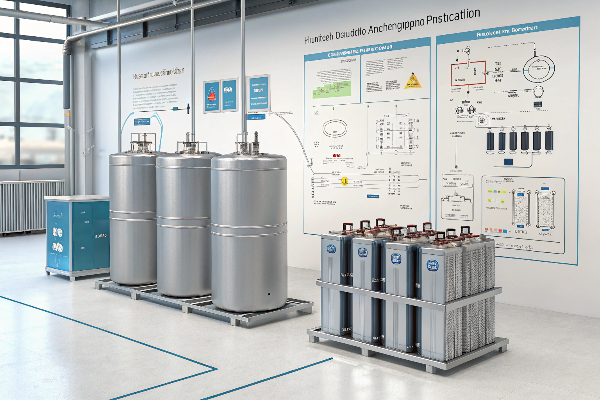
But the real magic happens when you understand how these anodes are changing the game. Let’s break down the future of electrolysis and see how titanium anodes are making large-scale hydrogen production a reality.
What are the specific challenges in scaling up hydrogen production via electrolysis, and how do titanium anodes address these challenges compared to other electrode materials?
Struggling with energy-intensive processes that fall apart under pressure? Scaling up hydrogen production1 is filled with hurdles, from fragile electrodes to sky-high energy bills.
Titanium anodes tackle these issues head-on with their robust corrosion resistance2, high electrocatalytic activity, and dimensional stability. This means they last longer, perform better, and are more efficient than alternatives like nickel or stainless steel.
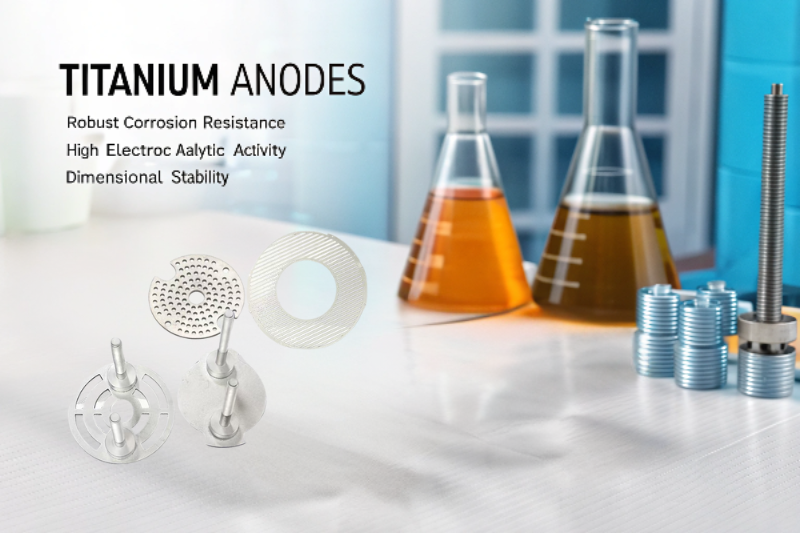
Challenges in Large-Scale Electrolysis and Titanium Anode Solutions.
Let’s dive deep into these challenges. Scaling up isn’t just about making more; it’s about doing it efficiently and sustainably.
Here is the challenges and Solution:
| Challenge | Description | Titanium Anode Solution |
|---|---|---|
| High Energy Consumption3 | Electrolysis requires significant energy input, making it costly. | Lower Overpotential: Titanium anodes, especially when coated with Iridium or Ruthenium, significantly reduce the energy needed for the oxygen evolution reaction, boosting overall efficiency. |
| Electrode Durability4 | Electrodes must withstand high current densities and harsh chemical environments without degrading. | Superior Corrosion Resistance: Titanium’s inherent properties and specialized coatings enable it to endure prolonged exposure to acidic or alkaline conditions without significant wear. |
| Scalability | Manufacturing electrodes on a large scale at a reasonable cost is vital for widespread adoption. | Cost-Effective Production: The manufacturing processes for titanium anodes are well-established, allowing for mass production without exorbitant costs. |
| System Integration | The fluctuating nature of renewable energy sources like wind and solar requires adaptable electrolysis systems. | Operational Flexibility: Titanium anodes can handle varying current densities, matching the intermittency of renewable sources, and maintaining consistent hydrogen production. |
| Material Cost | Reduce the dependence on expensive materials and lower the overall cost of production. | Optimized Coating Use: Innovations focus on minimizing precious metal usage through nanotechnology and composite coatings, cutting down expenses while maintaining high performance. |
| Lifespan Extension | Extend the operational life of electrodes to reduce maintenance and replacement costs. | Enhanced Structural Integrity: Advanced designs like 3D porous structures increase the surface area and lifespan of anodes, ensuring long-term operation with minimal maintenance. |
| Operational Efficiency | Maximize the efficiency of hydrogen production under varied conditions. | Adaptability to Conditions: Titanium anodes operate efficiently under a wide range of temperatures and pressures, making them suitable for diverse industrial applications. |
| Environmental Impact5 | Reduce the environmental footprint of the electrolysis process. | Sustainable Materials: Titanium is abundant and non-toxic, and improvements in coating techniques further minimize the environmental impact of anode production and use. |
| Safety | Ensure safe operation of electrolysis systems, especially at large scales. | Stable and Predictable Performance: Titanium anodes reduce the risk of unexpected failures or safety hazards, ensuring reliable hydrogen production even under demanding conditions. |
| Technological Maturity | Advance the technology to improve reliability and performance. | Continuous Innovation: Ongoing research and development in anode materials and structures are continually pushing the boundaries of what’s possible in electrolysis technology. |
| Integration Complexity | Simplify the integration of electrolysis systems into existing infrastructures. | Modular Design Compatibility: Titanium anodes can be easily integrated into modular electrolysis systems, allowing for flexible scaling and deployment in various industrial settings. |
| Market Acceptance | Increase market confidence in electrolysis as a viable hydrogen production method. | Proven Track Record: The increasing adoption of titanium anodes in real-world applications is building trust in their reliability and effectiveness, paving the way for broader market acceptance. |
I remember when I first started looking into hydrogen production, and the options seemed limited and inefficient. One of the first thing that impressed me about titanium anode.
What are the different types of electrolysis technologies (e.g., alkaline, PEM, solid oxide) used for hydrogen production, and what are the specific requirements for titanium anodes in each technology?
Confused about which electrolysis tech suits your needs? With so many options, from alkaline to solid oxide, choosing the right one can feel overwhelming, especially regarding their compatibility.
The main electrolysis technologies are alkaline (AEL), proton exchange membrane6 (PEM), and solid oxide (SOEC). Each demands different properties from titanium anodes: AEL needs alkaline corrosion resistance, PEM requires high activity and acid resistance, and SOEC demands high-temperature stability.

Deep Dive into Electrolysis Technologies and Titanium Anode Requirements.
Let’s dive deeper into these technologies. Each type has its unique environment and operational demands, which dictate what’s needed from the anode.
| Technology | Electrolyte | Operating Temperature | Titanium Anode Requirements |
|---|---|---|---|
| Alkaline (AEL) | Potassium/Sodium Hydroxide Solution | 60-90°C | Alkaline corrosion resistance, low oxygen evolution overpotential, stability in high pH environments. |
| Proton Exchange Membrane (PEM) | Solid Polymer Membrane | 50-80°C | High electrocatalytic activity, acid corrosion resistance, good conductivity, stability in low pH environments, often coated with Iridium or Ruthenium. |
| Solid Oxide (SOEC) | Solid Ceramic Material | 700-1000°C | High-temperature oxidation resistance, compatibility with electrolyte materials, stability in high-temperature oxidizing environments. |
| Anion Exchange Membrane(AEM) | Solid polymer electrolyte | 50-80°C | Cost-effective, operate in alkaline conditions, stable with non-precious metal catalysts, and potentially increase reaction rates. |
Back in days, I need to find the most effective setup, so I have ever done that. It was a practical lesson in how crucial the right anode is to efficiency and output.
What are the latest advancements in titanium anode coatings and structures to enhance their performance and durability in large-scale hydrogen production?
Are you tired of constantly replacing worn-out components in your hydrogen production setup? The fragility and short lifespan of electrodes can be a major setback.
Recent advancements include nanostructure coatings7, composite materials8, and doping modifications. These innovations increase surface area, combine material benefits, and optimize electronic structures, leading to enhanced catalytic activity and longer lifespans.
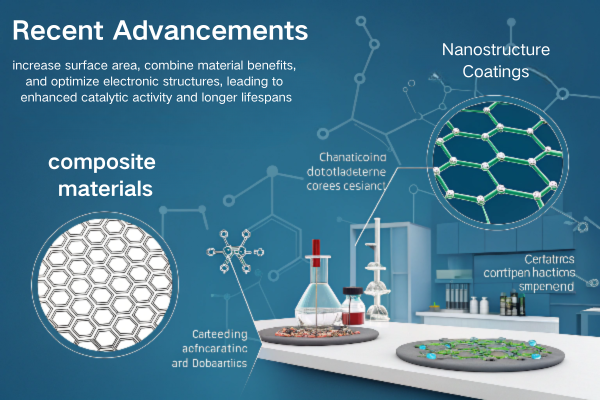
Exploring Cutting-Edge Titanium Anode Technologies
The advancements in coating technology are not just incremental improvements; they represent significant leaps in the efficiency and durability of electrolysis systems.
| Advancement | Description | Benefit |
|---|---|---|
| Nanostructure Coating1 | Application of coatings with nanoscale features. | Increases the specific surface area and number of active sites, enhancing catalytic activity. |
| Composite Coating | Combination of different materials in the coating. | Merges the advantages of various materials, improving both catalytic activity and stability under harsh conditions. |
| Doping Modification | Introduction of other elements into the coating material. | Optimizes the electronic structure and catalytic performance, enhancing efficiency and reducing energy consumption. |
| 3D Porous Structure2 | Development of anodes with a three-dimensional porous framework. | Improves mass transfer rates and provides a larger active area, significantly boosting the overall performance of the electrolysis process. |
| Microfluidic Electrode | Anodes designed with microfluidic channels. | Achieves a more uniform current distribution and reactant transport, enhancing efficiency and reducing the likelihood of localized degradation. |
| Reduced Precious Metal Content | Design strategies to minimize or eliminate the use of expensive precious metals like iridium. | Lower operational costs without sacrificing performance, making large-scale hydrogen production more economically viable. |
| Self-Healing Coatings3 | Innovative coatings that can repair minor damages autonomously. | Extend the lifespan of the anodes and reduce the need for frequent replacements, enhancing the reliability of hydrogen production. |
When I switched to using nanostructured coatings, the difference was night and day. My system’s efficiency jumped, and I spent less time worrying about maintenance.
How do operating parameters (e.g., current density, temperature, pressure) influence the efficiency and lifespan of titanium anodes in large-scale electrolysis?
Struggling to keep your electrolysis system running at peak performance? You’re not alone. It’s a common pain point to see efficiency drop and maintenance costs soar due to suboptimal operating conditions.
Key parameters like current density9, temperature10, and pressure11 dramatically affect titanium anodes. Higher current density boosts hydrogen production but can accelerate wear. Increased temperature10 lowers overpotential but risks corrosion. Pressure, especially in PEM electrolysis, enhances efficiency.
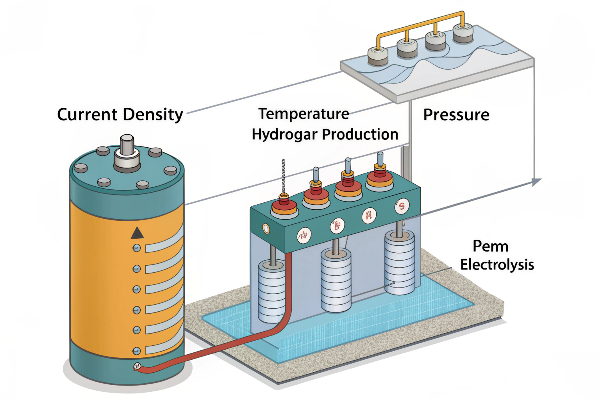
Optimizing Electrolysis: The Impact of Operating Parameters
These factors are interconnected and critical for both the effectiveness and the longevity of the electrolysis process.
| Parameter | Influence on Efficiency | Influence on Lifespan |
|---|---|---|
| Current Density | Higher density increases hydrogen production rates. | Excessive density can accelerate anode wear and degradation, reducing lifespan. |
| Temperature | Moderate increases can lower overpotential and enhance reaction kinetics. | Too high temperatures can accelerate corrosion and material degradation, shortening anode life. |
| Pressure | Has minimal effect on alkaline electrolysis; significantly enhances efficiency in PEM electrolysis at high pressure. | High pressure in PEM systems can lead to mechanical stress on components, potentially affecting lifespan if not properly managed. |
| Electrolyte Concentration12 | Optimal concentration ensures efficient ion transport. | Improper concentration can lead to increased resistance or corrosive effects, impacting anode longevity. |
| Flow Rate13 | Sufficient flow rate ensures uniform distribution of reactants and removal of products. | Inadequate flow can cause localized variations in concentration and temperature, leading to uneven wear and reduced anode lifespan. |
| pH Level | Maintaining the appropriate pH level is crucial for the stability of the electrode material. | Extremes in pH can accelerate corrosion or passivation of the anode, shortening its operational life. |
Proper management of these parameters is crucial. For instance, I once had to troubleshoot a system where simply adjusting the temperature made a massive difference in output stability.
What is the projected cost trajectory of titanium anodes for large-scale hydrogen production, and how does it compare to the overall cost of electrolytic hydrogen?
Worried about the high costs of scaling up hydrogen production? It’s a valid concern. Many people hit a wall when they see the initial investment needed for large-scale electrolysis.
The cost of titanium anodes is expected to decrease due to scalable production and advances in coating technology. While anodes are a significant part of the initial setup, ongoing innovations are driving down expenses, making them more competitive.

Analyzing the Economic Feasibility of Titanium Anodes
Understanding the cost dynamics is crucial for assessing the viability of large-scale hydrogen production.
| Cost Factor | Description | Impact on Overall Cost |
|---|---|---|
| Titanium Substrate Cost | The base cost of titanium material. | Forms a foundational part of the anode cost; relatively stable, but economies of scale can reduce this. |
| Precious Metal Coating Cost | Expenses related to iridium or ruthenium coatings. | A significant portion of the anode cost; innovations to reduce precious metal usage are critical for cost reduction. |
| Manufacturing Costs | Costs associated with the fabrication process of the anodes. | Includes labor, energy, and equipment; advancements in manufacturing techniques (e.g., automation) can lower these costs. |
| Raw Material Price Fluctuations | Changes in market prices of titanium and precious metals. | Can cause volatility in anode costs; strategic sourcing and material substitution can mitigate risks. |
| Large-Scale Production Savings | Efficiencies gained from mass production. | Higher production volumes lead to lower per-unit costs, making large-scale projects more economically viable. |
| Technological Advancements | Innovations like nanocoatings and reduced precious metal use. | Directly impact cost by enhancing material efficiency and reducing the need for expensive components. |
| Anode Cost as % of Total | The proportion of total electrolysis cost attributed to anodes. | Varies by technology (AEL, PEM, SOEC); generally, a significant but manageable portion of overall expenses. |
| Electricity Costs | The dominant cost in electrolytic hydrogen production. | While not directly related to anode cost, the efficiency improvements provided by better anodes can lower electricity consumption, thus reducing overall production costs. |
| Equipment Depreciation | The write-off of electrolysis equipment over time. | Longer-lasting anodes reduce replacement frequency, lowering depreciation costs. |
| Maintenance Costs | Expenses for upkeep and repair of electrolysis systems. | Durable anodes decrease maintenance needs, contributing to lower operational costs. |
| Comparison Across Technologies | Cost variations among AEL, PEM, and SOEC systems. | PEM systems, while more efficient, often have higher upfront costs due to precious metal use; AEL systems are cheaper initially but may have higher long-term operational costs due to lower efficiency and durability. |
From my experience, investing in better anode technology upfront pays off in the long run. It’s like choosing a high-quality tool; it might cost more initially, but its performance and longevity save money.
Conclusion
Titanium anodes are revolutionizing large-scale hydrogen production. With their durability, efficiency, and cost-effectiveness, these anodes are not just a component but a cornerstone of future electrolysis.
-
Understanding the challenges in hydrogen production is crucial for developing effective solutions and innovations in the field. ↩ ↩
-
Learning about corrosion resistance helps in selecting the right materials for efficient and durable electrolysis systems. ↩ ↩
-
Explore innovative solutions to reduce energy costs in electrolysis, enhancing efficiency and sustainability in hydrogen production. ↩ ↩
-
Learn how titanium anodes enhance durability and performance, ensuring long-lasting efficiency in electrolysis systems. ↩
-
Discover the sustainable benefits of titanium anodes and their role in reducing the environmental footprint of hydrogen production. ↩
-
Learning about PEM technology will provide insights into its efficiency and suitability for your hydrogen production applications. ↩
-
Learn how nanostructure coatings can revolutionize hydrogen production by increasing efficiency and durability of electrodes. ↩
-
Find out how composite materials can optimize performance and longevity in hydrogen production systems, making them more reliable. ↩
-
Understanding the impact of current density can help optimize your electrolysis system for better performance and longevity. ↩
-
Exploring temperature effects can lead to improved efficiency and reduced maintenance costs in your electrolysis operations. ↩ ↩
-
Learning about pressure’s role can enhance your system’s efficiency and overall performance in large-scale electrolysis. ↩
-
Exploring this topic can provide insights into maintaining optimal conditions for effective electrolysis. ↩
-
Learning about flow rate’s impact can enhance the design and operation of electrolysis systems for improved performance. ↩



